Eero 6 vs Eero 6+: Which Eero is Best For You in 2023?
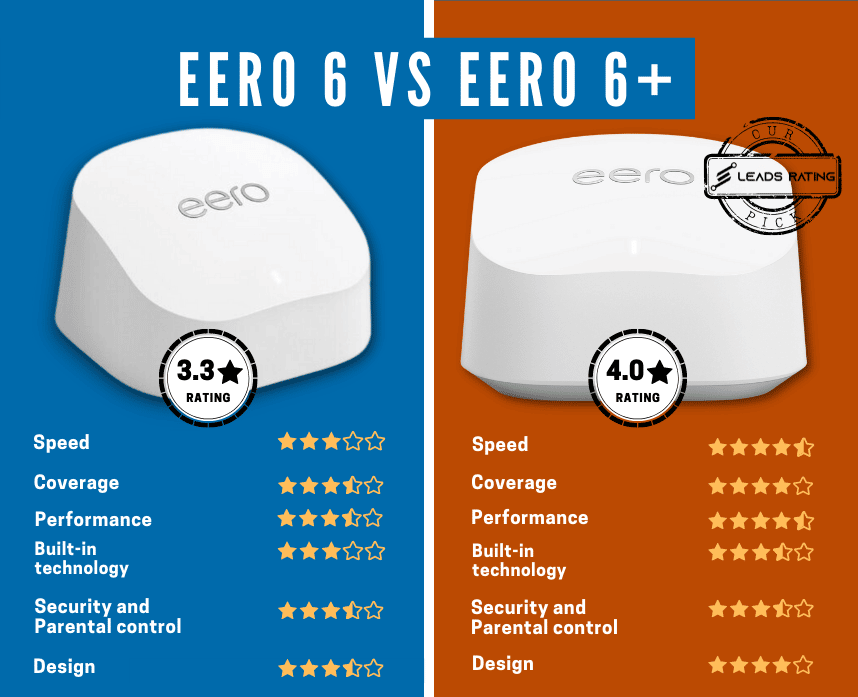
Eero is one of the most popular mesh systems in the market today. In this article, we’ll compare Eero 6 vs. Eero 6+ to see which mesh system is best for your home or office. Plus, what really changed anyway?
Eero 6 and Eero 6+ have a lot of similarities, starting from the design to the wireless range. Additionally, both are dual-band mesh routers that support the latest Wi-Fi 6 technology.
The thing is, Eero 6 is best for homes with fewer user demands. Then, Eero 6+ is best if you’re looking for a mesh system with faster speeds and overall better performance.
Let’s get into more details and see which mesh network best suits your needs.
Table of Contents
Eero 6 vs. Eero 6+ In a nutshell
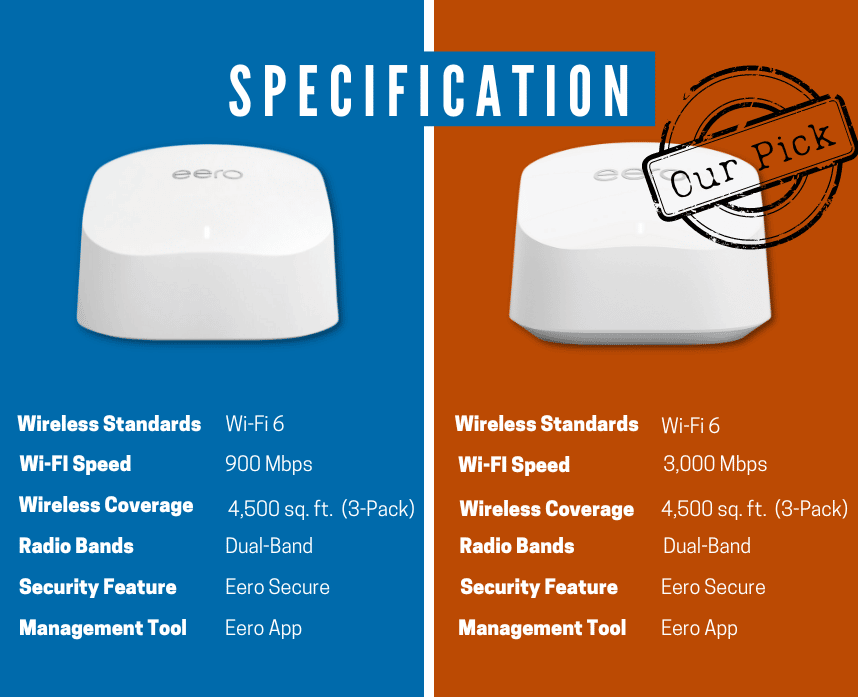
| SPECIFICATION | 6 | 6+ |
| Wireless Standards | Wi-Fi 6 | Wi-Fi 6 |
| Wi-FI Speed | 900 Mbps | 3,000 Mbps |
| Wireless Coverage | 4,500 sq. ft. (3-Pack) | 4,500 sq. ft. (3-Pack) |
| Radio Bands | Dual-Band | Dual-Band |
| Security Feature | Eero Secure | Eero Secure |
| Management Tool | Eero App | Eero App |
Honestly, there isn’t a big difference between the Eero 6 and Eero 6+. Both models support Wi-Fi 6, which promises lightning-fast speeds.
On top of that, they support mandatory built-in technologies like OFDMA, 2X2 MU-MIMO, and beamforming.
These technologies let the mesh network manage up to 75 devices. They also make sure that your devices are getting optimum speeds.
You can get both models in different variations and combinations. However, it’s important to remember that these aren’t backward compatible. This means you can’t mix and match any previous generation models to new ones like Eero Pro 6 and Eero Pro 6E.
As mentioned above, Eero 6 is best for small to mid-sized homes with fewer user demands. It supports AX1800, so its maximum throughput goes up to 1800 Mbps only. It’s not very ideal if you love to stream videos all day and play games at the same time.
As for the Eero 6+, it’s perfect for mid-sized to average-sized homes. We also recommend it as great router for people living in apartments. It supports AX3000, so it can manage more devices and perform much better than the Eero 6. It’s not ideal for gaming, but you can definitely do heavier online activities with it.
Winner: Eero 6+
Performance
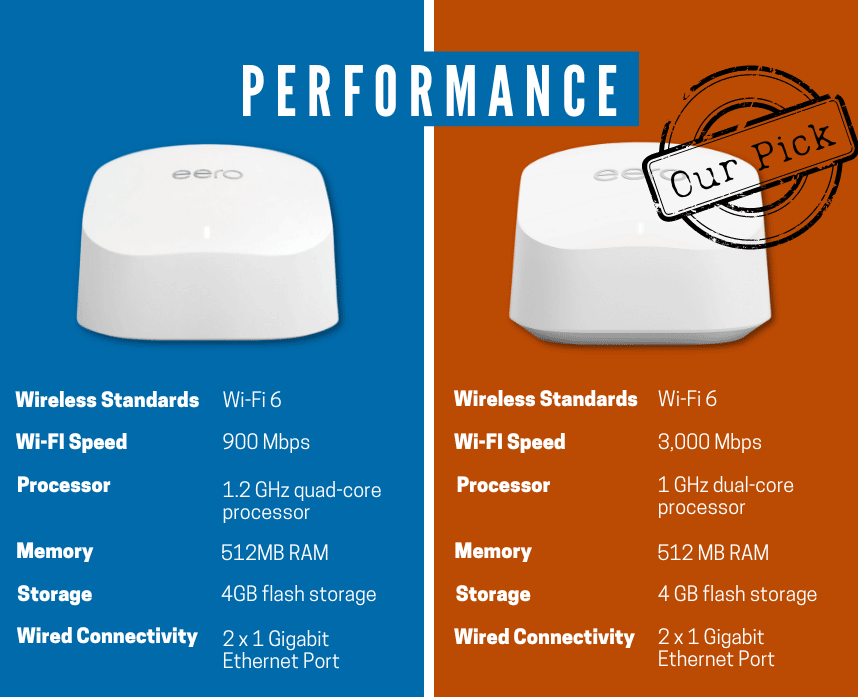
| SPECIFICATION | 6 | 6+ |
| Wireless Standards | Wi-Fi 6 | Wi-Fi 6 |
| Wi-FI Speed | 900 Mbps | 3,000 Mbps |
| Processor | 1.2 GHz quad-core processor | 1 GHz dual-core processor |
| Memory | 512MB RAM | 512 MB RAM |
| Storage | 4GB flash storage | 4 GB flash storage |
| Wired Connectivity | 2 x 1 Gigabit Ethernet Port | 2 x 1 Gigabit Ethernet Port |
Frankly speaking, Eero 6+ definitely outperforms the Eero 6. In fact, it did quite well in our tests of the best eero routers.
Although both support Wi-Fi 6 technology, Eero 6+ offers more advanced specs.
Eero 6+ supports up to gigabit speeds, and its maximum throughput goes up to 3,000 Mbps. It offers a higher capacity for more devices. Plus, it offers faster speeds.
Another thing is, it supports 160MHz channel bandwidth. With this, compatible devices like laptops, gaming consoles, or mobile devices can get average speed up to 1730+ Mbps.
Why is it important? Well, more bandwidth means more connected devices can get top max speeds.
Meanwhile, the Eero 6 only supports up to 80MHz channels, which is half of what the Eero 6+ offers. It also supports internet plans of up to 500 Mbps, and its maximum throughput goes up to 1,800 Mbps.
Using Wi-Fi 6 devices like the iPhone 13 Pro Max, we put the two mesh routers to the test.
With a wired backhaul, Eero 6 gave almost 800 Mbps speeds. Then, the Eero 6+ provided 980 Mbps, which is strikingly impressive.
Through the wireless backhaul, there’s a significant drop in the Eero 6. It only provides up to 400 Mbps, but it didn’t go below 200 Mbps.
Even though the Eero 6+ is a dual-band router, it has an outstanding performance. The internet speeds went up to 600 Mbps and didn’t go lower than 400 Mbps. You’d normally see speeds like this on a tri-band mesh because of the additional 5GHz band.
Generally, speed and performance-wise, the Eero 6+ offers such a huge advantage. So if you’re looking for a mesh Wi-Fi network that offers fast speeds and higher capacity, this is the way to go.
Winner: Eero 6+
Features and Design
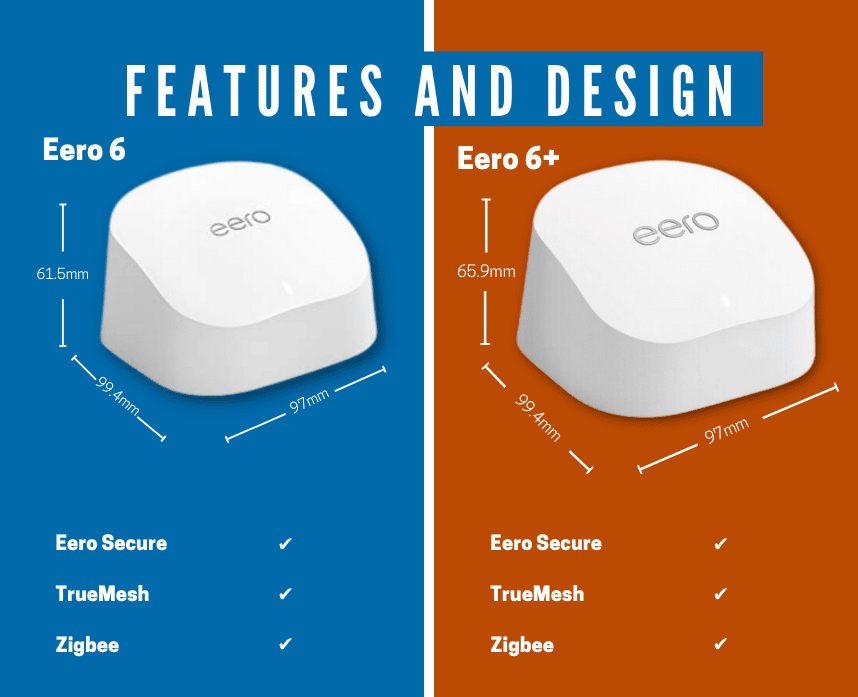
| SPECIFICATION | 6 | 6+ |
| Dimension | L: 99.4mm x W: 97mm x H: 61.5 mm | L: 99.4mm x W: 97mm x H: 65.9 mm |
| Eero Secure | ✔ | ✔ |
| TrueMesh | ✔ | ✔ |
| Zigbee | ✔ | ✔ |
In terms of design, both mesh routers share a lot in common. Both of them are small and compact, which is great for blending in behind home decor. However, the Eero 6+ is slightly taller.
Nevertheless, it’s still a pretty solid mesh with a signature glossy, white plastic case. If you’re into minimalist designs, we’re sure you’ll like these two.
Features-wise, both mesh routers are protected by Eero Secure and Eero Secure Plus. Eero Secure is the security software that gives you more advanced security and parental control.
For a $3 monthly subscription, you can get features like parental controls, site blocking, and many others.
Getting an Eero Secure Plus subscription gives you extra security options like a password manager, VPN, DDNS, and antivirus. However, this’ll cost you more money as the subscription is $30 a month.
Additionally, both mesh systems have a built-in Zigbee radio. it lets your mesh devices connect to smart home devices through Alexa. This makes a big difference because you won’t need to buy an adapter anymore!
Winner: Tie
Setup Process
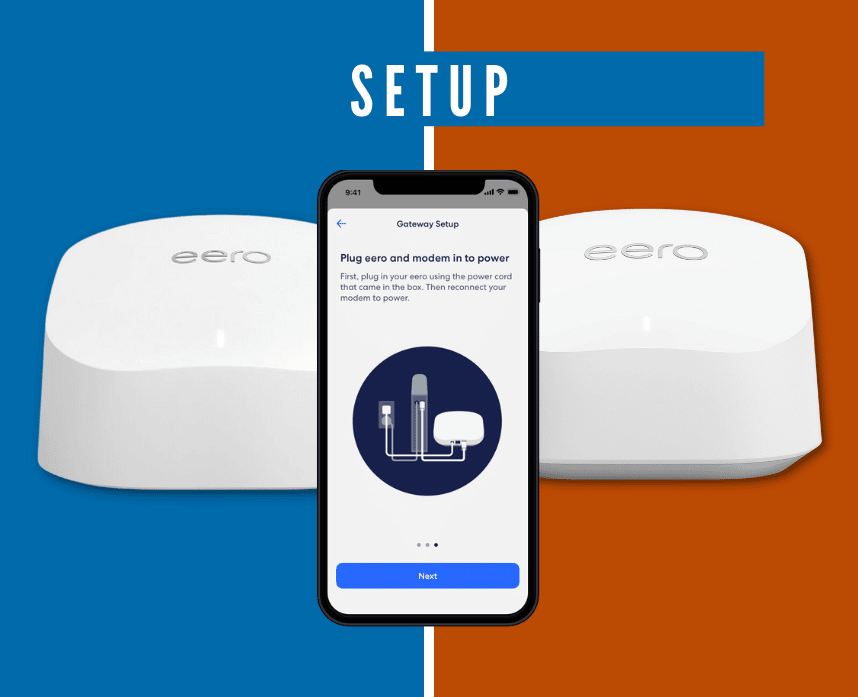
Setting up your Eero devices is as easy as 1-2-3! You need the Eero app on your phone, and you’ll be ready to go in just a few taps.
Ideally, you’d get instructions upon downloading the app. but here’s a quick breakdown of the installation and setup process:
- Download the Eero app.
- Sign in using your Google or Amazon account. If you don’t have an account yet, register and create one.
- Follow the instructions on the app.
- Let the app scan existing Eero devices.
- Set up your network name and password.
We know that manually connecting all your existing devices can be a hassle. So to solve that, all you need to do is put the same name and password as your old mesh network.
This is case-sensitive, so make sure to get all the upper and lower cases right.
Once you do this, all your wireless devices should automatically connect to your new mesh network.
In addition to the setup process, you can configure your Eero mesh network in 2 ways: wired or wireless backhaul.
A wired backhaul gives you maximum speeds. You need to connect one Eero device to the modem to do this. That will function as the gateway router. Then, you will connect the other nodes through an ethernet connection.
Now, a wireless backhaul offers slower speeds than the previous configuration method. You have to connect the gateway router to the modem. Then, the satellites will communicate wirelessly to ensure reliable speeds and optimum coverage.
Pros and Cons
Generally, both mesh network systems are great investments. But, you need to decide based on your needs, preferences, and budget.
Each model has its own sets of strengths and drawbacks. Here are the pros and cons to help you make wiser decisions.
Eero 6 Pros and Cons
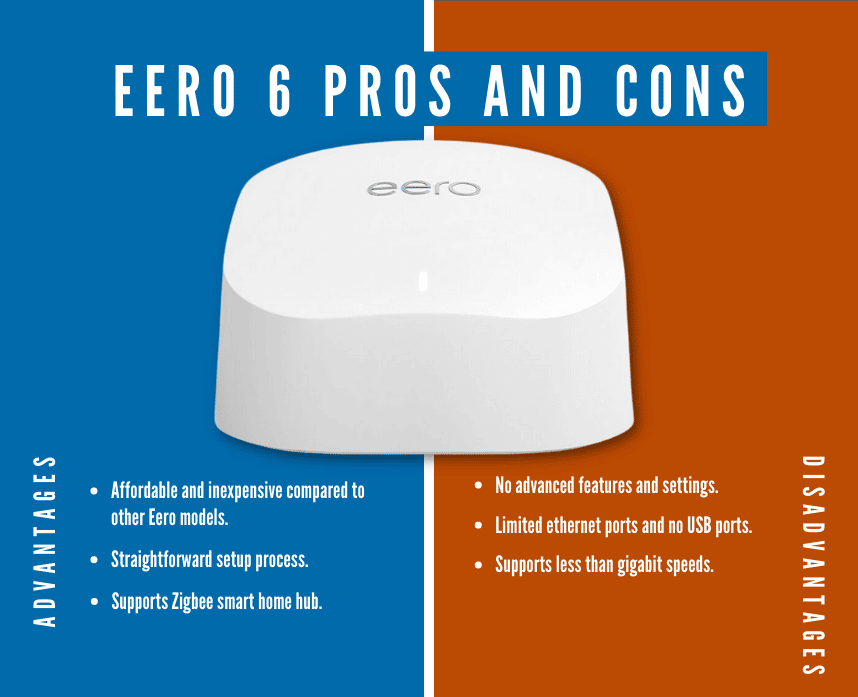
| PROS | CONS |
| Affordable and inexpensive compared to other Eero models. | No advanced features and settings. |
| Straightforward setup process. | Limited ethernet ports and no USB ports. |
| Supports Zigbee smart home hub. | Supports less than gigabit speeds. |
Buy Eero 6 if you are a beginner who’s trying to test out mesh systems. With the user-friendly app and easy setup process, you’ll never get lost or overwhelmed!
But, if you want to maximize gigabit connections or your internet plan is above 500 Mbps, you can try other models. Or you can also try out more advanced mesh systems like Netgear or Asus.
Our in-depth review of the Eero 6 will give even more details.
Eero 6+ Pros and Cons
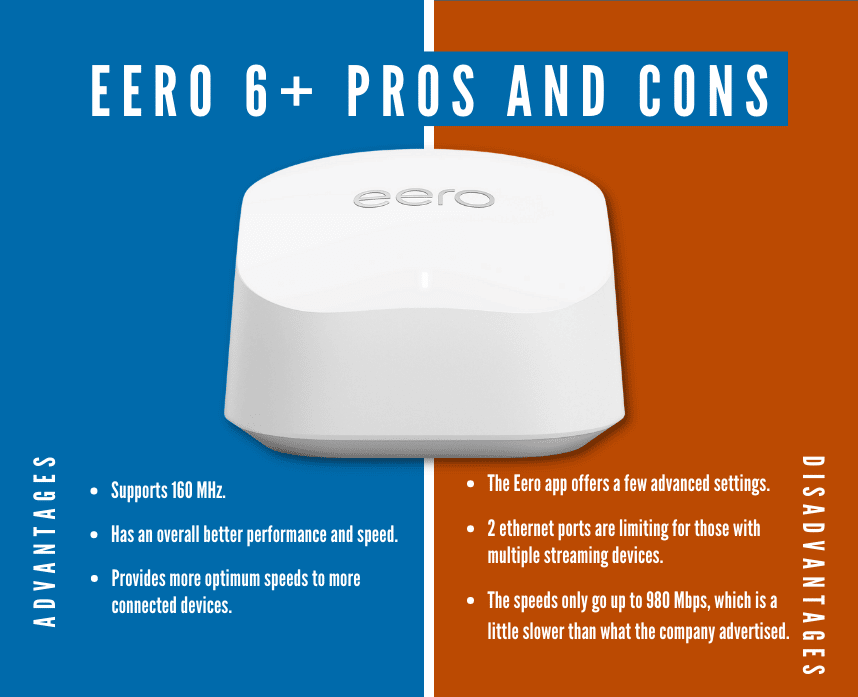
| PROS | CONS |
| Supports 160 MHz. | The Eero app offers a few advanced settings. |
| Has an overall better performance and speed. | 2 ethernet ports are limiting for those with multiple streaming devices. |
| SProvides more optimum speeds to more connected devices. | The speeds only go up to 980 Mbps, which is a little slower than what the company advertised. |
Go ahead and buy Eero 6+ if you want an upgrade for your home. It’s faster and has a higher capacity than the Eero 6. Additionally, it’s a great mesh system for mid-sized and average-sized homes.
But, don’t buy it if you have dozens of devices for gaming and streaming. It only has 2 ethernet ports, you might not get the best gaming experience if you play online games wirelessly.
The Final Verdict: Eero 6+ Wins
The Amazon Eero series is an outstanding mesh Wi-Fi system. But, after comparing the specs and their capabilities, the Eero 6+ is definitely a better investment.
We hope that our Eero 6 vs Eero 6+ review has helped you more than we hoped. Check out amazing deals for Eero 6 and Eero 6+ on Amazon here.
Related Articles:

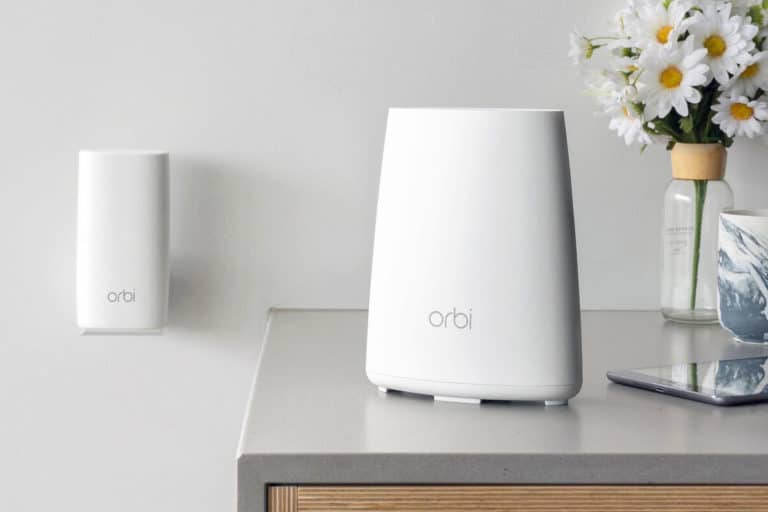


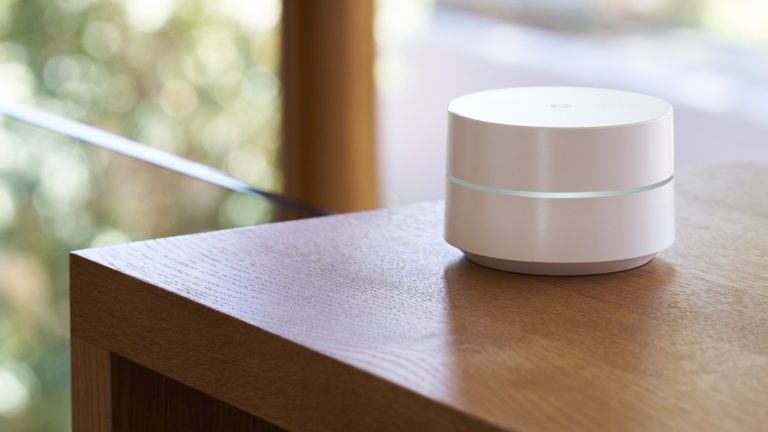
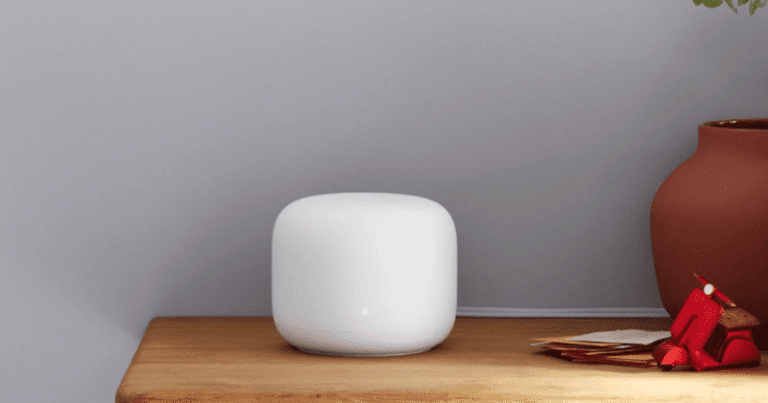
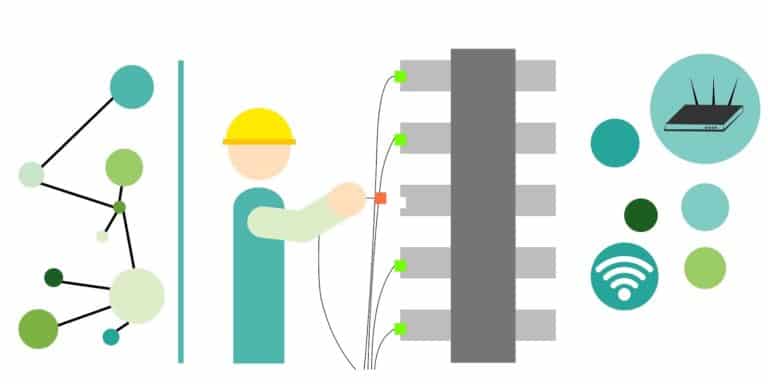
Great review, it was an easy read. Easy to understand very straightforward.